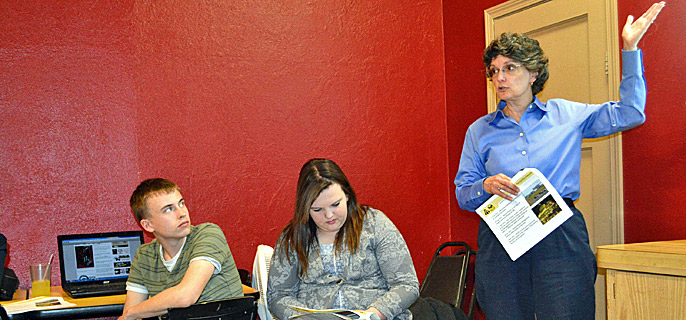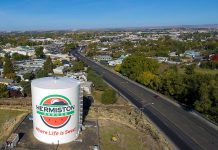
[quote style=”2″]Jobs Disappearing as Depot Closure Progresses[/quote]
Less than two years ago, more people, approximately 1,350, worked out at the Umatilla Chemical Depot than anywhere else in the area. Today there that number is down to 530 and getting smaller by the month.
URS Project General Manager Julia Hamrick was among a trio of speakers at the Umatilla Chamber of Commerce’s Business-to-Business lunch on Thursday. She gave an overview of the ongoing phases of the depot’s closure activities, as well as how they are impacting employment at the facility.
“As we go through the closure process, one thing that’s impacted is people,” Hamrick said. “As we get through different phases of the project, we don’t have needs for certain skill sets so we have to de-staff over time.”
Hamrick said 180 people were laid off in February and 38 more are scheduled to be laid off in May with more to follow.
“When we get ready to shut down the control room, we’ll be laying off 196 more,” she said. “A couple months after that, at the start of demolition, we’ll lay off another 150 people, so it’s going to be a little bit of a depressing time. It’s just part of the project.”
Preparations are under way for the demolition of the Munitions Demilitarization Building. Northwest Demolition out of Tigard was awarded the contract in 2011.
“They are working on their paperwork,” Hamrick said. “Demolition should start in August.”
Unlike a lot of people who are laid off by large organizations, workers out at the depot have known for some time that their jobs would be coming to an end.
“Our staffs have been communicated with, we’ve been talking to them for over two years about what’s going to happen,” Hamrick said. “We’ve been working with them to get education or applying to other projects. We have other projects in Pueblo (Colo.) and Blue Grass (Ky.) that we’d really like these experienced people to go to. Some people will just want to retire and stay in the area or do something else.”
Of the nearly 200 people who’ve been or soon will be laid off this year, 88 have transferred to other URS projects.
“That’s a pretty high retention rate for this type of activity,” Hamrick said. “We’re pretty proud of that and we continue to work with our sister projects to see if we can get more people to go to those sites.”
In the meantime, the closure process is continuing at the depot. Much has already been completed, including the removal of equipment from the site as well as the decontamination process. Sampling and monitoring is now taking place.
Related Article: Phil Ferguson Talks About Future of Depot Land
“When the facility was being built, there were some background samples that were taken around the footprint of the facility so that when we were done we knew what the soil was like before,” Hamrick said.
But regulations and sampling methodologies have changed over the years, requiring additional samples to be taken.
“Last year we completed doing what we call baseline area samples all around the footprint of the building on the upwind side of the building – just to get a good appreciation for what is actually in the soil,” said Hamrick.
After the Munitions Demilitarization Building is demolished and the area cleaned up, additional samples will be taken “so we can go back to those baseline samples and compare what we have after cleanup to what we had before.”
Hamrick said soil verification sample began this week, but likely won’t be completed until late 2014.
“It takes a long time to do all of these samples,” she said. “Most of them we can’t do until most of the demolition of the building is complete.”
Unventilated Monitoring Tests or UMTs are wrapping up inside the Munitions Demilitarization Building. UMTs have been completed in 11 of the 12 zones of the building and the 12th should be completed next week, Hamrick said.
When the sampling and monitoring process is complete, the demolition phase can begin in earnest. Some of that work has already begun and the Brine Reduction Area was demolished in late 2011.
“Then, when we’re done with (demolition), it’s basically paperwork,” Hamrick said. “We’ve got to compile all the reports that demonstrate that we did what we said we’d do.”








